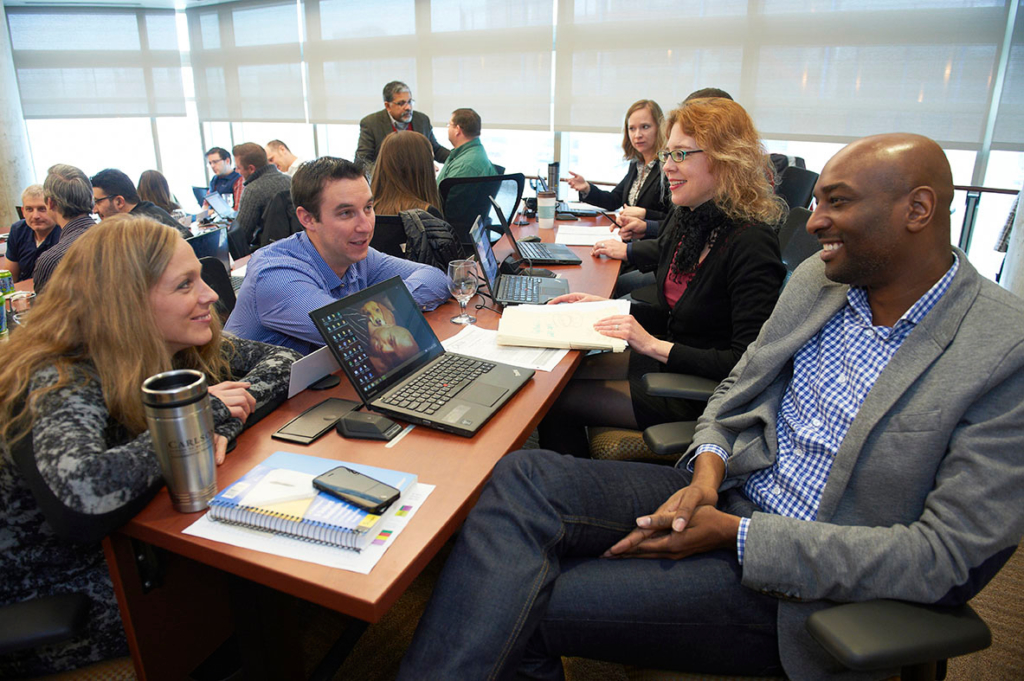
Executive MBA students at Carlson School of Management come to campus every other weekend, or they can Zoom into classes if their schedule and circumstances require it. Photo by Tony Nelson
What would you say are the differentiators for the Carlson EMBA?
I think, geographically, we are really, really lucky. Now, I say this because our program primarily draws from the region, and I don’t know if you’ve been to Minneapolis in the winter, but it’s not really a destination people are excited to go to in the winter. But, our industry is so diverse here that we don’t have to try, we have a great cohort that’s always very diverse. We also sit right inside a city which is different from a lot of big 10 universities and big public schools. We are in it, and it’s pretty amazing in terms of access to companies.
Curriculum wise, we just launched a new curriculum this year.
The traditional full-time MBA program is where all of these programs were born from. And while, we know the EMBA program is very different in what’s going on in the discussion and what’s happening in the classroom, on paper, all our MBA programs look pretty similar. A prospective student doesn’t understand those differences when they’re looking at what’s your curriculum.
How is the new curriculum different from previous years, and from your other MBA programs?
In a traditional MBA, students take their core and then choose a functional area to specialize or focus on. In the EMBA, it’s kind of the reverse. Our students come in with significant functional experience in their area of expertise and need the tools and skills to lead across functional areas and at high levels in the organization. Because of that, our curriculum is built to intentionally be much broader and put a bigger focus on leadership and strategic decision-making.
We focus on strategy, leadership, and decision-making on a global scale. We work with them on foundational competencies, core functions of the organization, solutions through people, the executive experience, and our experiential learning.
We want them to have exposure to the C-suite in an intimate way beyond the guest speakers that we have in class. Yes, our faculty routinely bring in leaders involved in the case studies they are working on or to supplement a topic in class, but we’ve also added a Top Management Perspectives course that brings CEOs to them in a small, fireside chat manner, where they have great access to great leaders.
How did the new curriculum come about?
We had a great faculty committee, and we started interviewing alumni who were in leadership roles at a variety of different types of organizations. What did we get right? What did we miss? That kind of thing.
We reached out to school partners — companies that recruit for one of our other programs and people who have some affiliation with the school but not necessarily the EMBA program. We wanted to know, ‘What are you looking for when you are hiring executives or people in leadership roles?’
We took all that, and starting from a blank sheet of paper, we built the curriculum that way. Keeping in mind, an MBA still has certain requirements, and we wanted this to be a full MBA program as it always has been. But we spent a couple of years looking at how much we were teaching the different core areas.
We heard a lot about leadership, team skills, ability to lead others, strategic decision making, and all of these things that I think people get out of their MBA, but we wanted to be really, really deliberate about it. We wanted to make sure we weren’t in the weeds. So, how do we shift some of that core MBA coursework to really be applicable for this group, and what else do they need? We ended up adding credits to the program.
How many credits?
We are at 52.5 credits. We were at 48. Not a big increase, but we have the core MBA functions now along with more about the executive experience. Even just getting a lot more face time with CEOs, I’d say it’s just more deliberate.
What do you think sets Carlson students apart?
I think it's more of the culture piece. Our students are really collaborative, and maybe that's true everywhere. There's definitely a range in the room. Everybody is not in the C-suite. Some of them are coming from a place where they have been a senior manager or, with a lot of the companies we have, they might be in a scientific role or an engineering role and they're making that jump to the business side. We also have the people who are running organizations or divisions of big companies. And, in the classroom, they are peers. I think that's a really great thing for everybody.
We can have a student in the program who's 29, 30 years old alongside a student who's closer to 60. They're peers on that team and they learn from each other. I know we hear business people are all Type A and competitive, and some of that might be true, but I see so much collaboration. Not only on the classroom side, but just personally with what they have things going on in their lives. They're very supportive of each other.
What kinds of demand trends have you been seeing for the EMBA, both in your program and more generally?
Being involved on the EMBA Council, I think what I have seen, certainly, and this isn't just here, is that corporate support for education of any kind has diminished. There's less financial support for the students. I think a lot of companies are focusing on their in-house, more tailored, exec ed, non-degree custom programs. The students we get in an EMBA program, they're doing all that with their company. They're really looking to have that external perspective. So when we talk to them, their company has an MBA, and they don't want to sit in a room full of people from their company. They want that diversity of thought.

The Carlson School of Management campus sits in downtown Minneapolis, making it easy for industry executives to visit classes. Courtesy photo
I don't know what's going to happen with that as all of our tuitions go up. There's a lot more pressure on the student. From that standpoint, in some ways, I think that's good because you get the students who really, really want to do this.
What do I think is going to happen? I'm not sure. This job market is so weird. For a long time, students were constantly changing jobs and getting promoted. That slowed down a little bit quietly. I think it'll be interesting to see what happens.
What kinds of opportunities do you see out there in the EMBA market for Carlson, and what are some of the challenges you are keeping an eye on?
I think this decision to make this a hybrid program, which is a really big leap at a public research university, is an opportunity. Right now, it's been kind of just a soft launch. We started it during COVID, and then we kept it and made it better. We're going to actively pursue that moving forward. The test will be attracting students who don't live in the region and seeing if we attract true hybrid students.
I think that's something new, not just to us. In talking with EMBA colleagues, people are very split on the hybrid format. There are some who were like, 'absolutely no more Zoom.' None of us know what's going to happen or how that's going to work.
In the past, you were either an online program or you were an in-person. Now there's some of us who are kind of in the middle. The other big change is there are so many options, and you don't have to be able to get to where your program is anymore. That's really opened things up for students. I think it's a whole new marketplace out there.
Could that new marketplace lead to growth in the program?
I don't know if I would look at it as growth growth. I think all of us are looking at the market. The market itself is so big and saturated now it's more, How do we maintain?
For us, the advantage of the hybrid piece is twofold: One, yes, this is another channel to look at for finding students. It's also providing our current students, and the people who were going to come here anyway, with more flexibility. I don't think we can go back to where we lay down these hard and fast rules. when that's not what the workplace is like anymore. You can go look at downtown where these companies are headquartered, and people didn't come back. They sent the workforce home and said, "You can stay there if you want." We need to be thinking like the businesses are and helping our students function that way as well.
DON’T MISS THESE STORIES IN OUR EMBA SPOTLIGHT SERIES:





Questions about this article? Email us or leave a comment below.